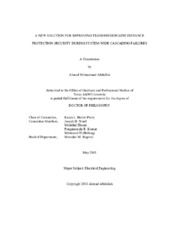| dc.contributor.advisor | Butler-Purry, Karen | |
| dc.creator | Abdullah, Ahmad Muhammad | |
| dc.date.accessioned | 2019-01-17T19:34:03Z | |
| dc.date.available | 2020-05-01T06:24:29Z | |
| dc.date.created | 2018-05 | |
| dc.date.issued | 2018-04-27 | |
| dc.date.submitted | May 2018 | |
| dc.identifier.uri | https://hdl.handle.net/1969.1/173579 | |
| dc.description.abstract | Protection misoperation is responsible for a large portion of all cascading failures. These cascading failures can lead to blackouts that have tremendous social impacts. This dissertation proposes a new method that uses local distance relay instantaneous three-phase currents to enhance the security of distance protection of transmission lines during wide-area cascading events. The method incorporates advanced signal processing techniques and pattern recognition approaches to prevent zone 3 distance protection misoperation.
Prevention of misoperation is done through three major stages. The first stage is fault detection. In this first stage, the proposed method merely recognizes that a fault exists somewhere in the transmission system. The second stage determines whether this fault is within the distance relay’s protective reach. The last stage detects whether this fault has been cleared. If the second stage determines that the fault is outside the zone 3 reach of the relay, a blocking signal will be sent to the relay to prevent operation even if the impedance falls within the operating characteristics of the relay. Alternatively, if the second stage determines that the fault is indeed within zone 3 protection reach of the relay, a permissive trip signal will be sent to the relay only if the third stage determines that the fault has not been cleared yet.
The first and second stages use three different k-nearest neighbor classifiers that are trained using level 3 detail coefficients of discrete wavelet transform of the aerial mode currents. The third stage uses the current fundamental to detect fault clearing.
Several wide area cascading scenarios were simulated, and various performance metrics were analyzed to study the effectiveness of the proposed methodology. | en |
| dc.format.mimetype | application/pdf | |
| dc.language.iso | en | |
| dc.subject | distance relaying | en |
| dc.subject | machine learning | en |
| dc.subject | pattern recognition | en |
| dc.subject | zone 3 protection | en |
| dc.subject | wide area cascading failures | en |
| dc.subject | blackouts | en |
| dc.subject | faults | en |
| dc.subject | lightning | en |
| dc.title | A New Solution for Improving Transmission Line Distance Protection Security During System-Wide Cascading Failures | en |
| dc.type | Thesis | en |
| thesis.degree.department | Electrical and Computer Engineering | en |
| thesis.degree.discipline | Electrical Engineering | en |
| thesis.degree.grantor | Texas A & M University | en |
| thesis.degree.name | Doctor of Philosophy | en |
| thesis.degree.level | Doctoral | en |
| dc.contributor.committeeMember | Ward, Joseph | |
| dc.contributor.committeeMember | Ehsani, Mehrdad | |
| dc.contributor.committeeMember | Kumar, Panganamala | |
| dc.contributor.committeeMember | El-Halwagi, Mahmoud | |
| dc.type.material | text | en |
| dc.date.updated | 2019-01-17T19:34:04Z | |
| local.embargo.terms | 2020-05-01 | |
| local.etdauthor.orcid | 0000-0001-7589-1803 | |


